Peculiarities of the 2023 Crimean Holiday Season — a «Tourism» in Camouflage
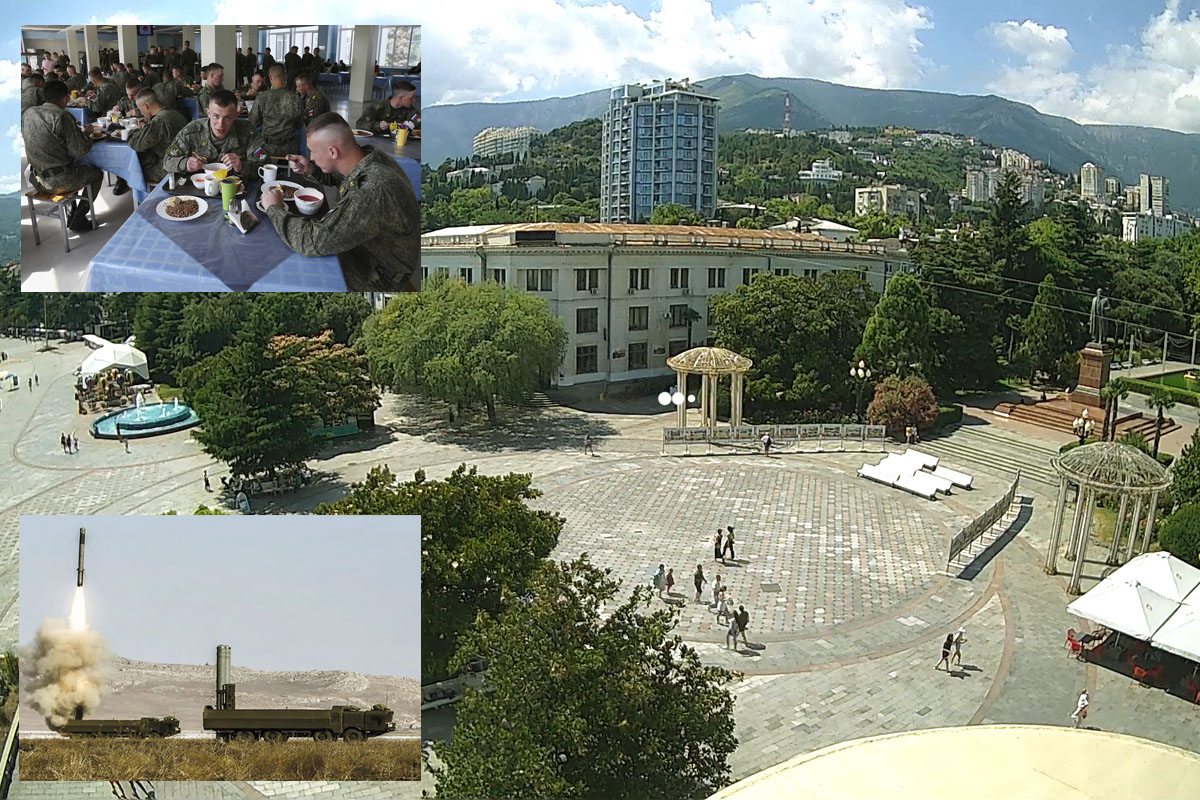
The Monitoring Group of BlackSeaNews and
the Black Sea Institute of Strategic Studies continues publication of the report:
Crimea During the Great War. The Situation in the Occupied Crimea in 2022-2023. Military Context (1) by:
Tetyana GUCHAKOVA,
Tetyana IVANEVICH,
Andrii KLYMENKO
This report is a logical continuation of the authors’ previous works published in 2021, 2020, 2019 and 2018 (see the Crimean Library section of the website).
Part 1 of the report can be found here: Crimea During the Great War. The Situation in the Occupied Crimea in 2022-2023. Military Context (1).
Part 2 of the report can be found here: Crimea During the Great War. Warfare and «New Types of Tourism» (2).
2.2 Peculiarities of the 2023 Crimean Holiday Season
Let’s remind the important conclusion the authors concluded in the previous part of the report:
The real Crimean tourist flow volume before the Great War was up to 2.5 million people a year, which is 2-2.5 times less than the estimated number of tourists before the occupation — 5-6 million people/10-14 days — and 3.2 times less than in Soviet times — 8 million/20-24 days.
The real tourist flow volume to the occupied peninsula in 2022 can be estimated at up to 1.5 million people, and in the current 2023, according to available data on the drop in bookings — at up to 1 million people per year, provided that the 2023 season will continue to be an extreme «war zone tourism» it is now.
«Tourism» in camouflage
For starter, it is worth looking at the table below with the latest Russian official statistics:
| Restaurants, cafes and bars. Food service turnover | ||||
|
|
January-May 2023 |
May 2023, % |
||
|
|
million rubles | % of the January-May 2022 | May 2022 | April 2023 |
| Southern Federal District |
115412,2 |
146,8 |
143,5 |
104,6 |
| Republic of Adygea |
1582,7 |
103,2 |
117,8 |
102,4 |
| Republic of Kalmykia |
473,3 |
73,2 |
57,4 |
99,1 |
| Republic of Crimea |
16406,8 |
187,8 |
163,8 |
106,8 |
| Krasnodar Krai |
39160,0 |
105,5 |
112,1 |
105,7 |
| Astrakhan Oblast |
4866,3 |
110,2 |
108,9 |
100,7 |
| Volgograd Oblast |
9097,9 |
116,4 |
121,8 |
104,4 |
| Rostov Oblast |
35065,4 |
177,2 |
177,6 |
101,8 |
| City of Sevastopol |
8759,8 |
196,9 |
170,2 |
109,7 |
Thus, during the low tourist season of January-May 2023, the turnover of Crimean food outlets increased by a huge 87.8% compared to the same period in 2023, and in May — by 63.8% compared to May of the previous year, while in Sevastopol — by 96.9% over 5 months and in May — by 70.2% compared to the previous May.
Let’s note another more revealing detail: in January-February 2023, i.e., during the «dead tourist season,» the food service turnover in Sevastopol amounted to 288.9% increase compared to January-February 2022. In the rest of Crimea, the ratio was similar: 294.9% in January-February 2023, compared to January-February 2022.
For reference, in Krasnodar Krai, that has a much larger and practically year-round resort and tourism industry than Crimea concentrated in Sochi, Anapa and Gelendzhik, the food service volume grew by only a reasonable 5.5%.
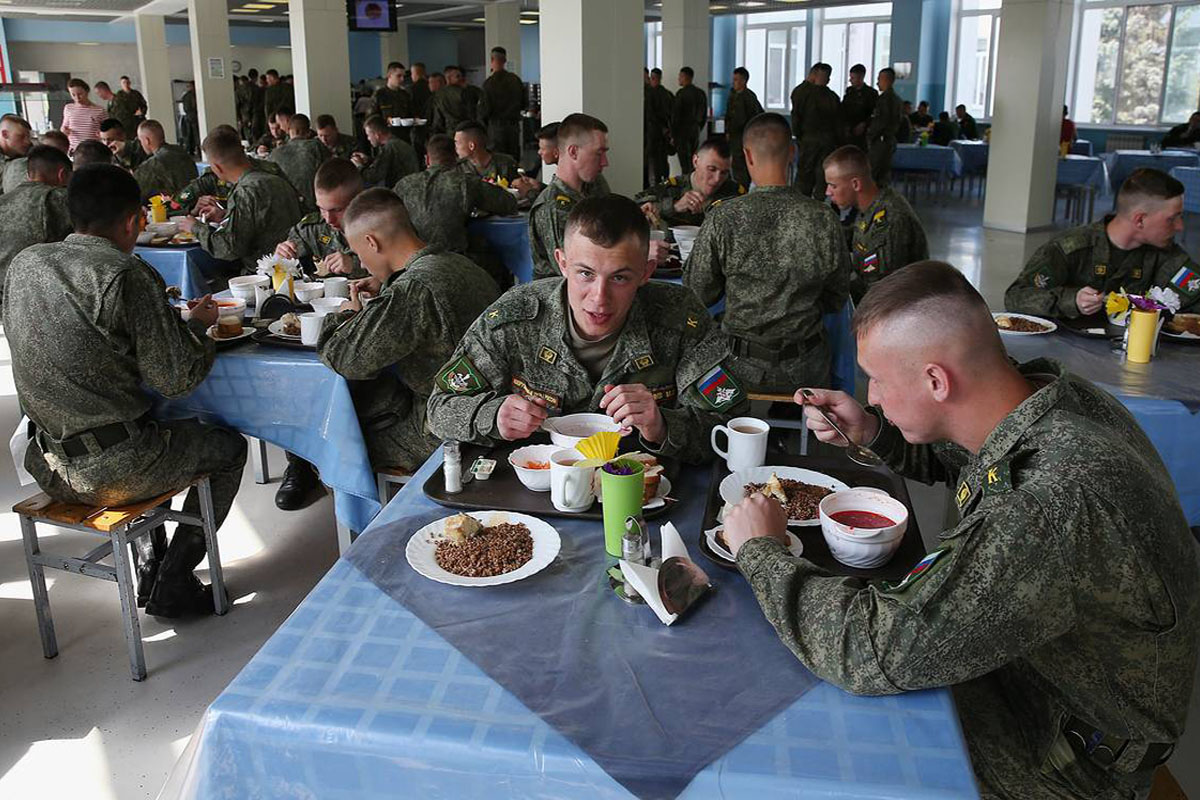 What accounts for the giant spike in retail turnover in Crimea and Sevastopol is the presence of a huge number of Russian military men with good appetite.
What accounts for the giant spike in retail turnover in Crimea and Sevastopol is the presence of a huge number of Russian military men with good appetite.
The same goes the Rostov Oblast, the region where Russia's large army units involved in the war against Ukraine are deployed — for its 177% spike it should thank the «tourists in camouflage.»
That is, the overwhelming majority of the 2022-23 «new Crimean tourists» are Russian military personnel permanently or temporarily stationed in Crimea or transiting to the war zones in Kherson and Zaporizhzhia regions.
It should be noted that dozens of health resorts, boarding houses, recreation centers, and children's summer camp facilities are «owned» and/or managed by the occupation administrations of Sevastopol and Crimea and various Russian ministries and agencies, including the Ministry of Defense and special services, as well as those Russia’s regions, seized and appropriated during the years of occupation. Many of them accommodate Russian serviceman.
A new type of «medical tourism»
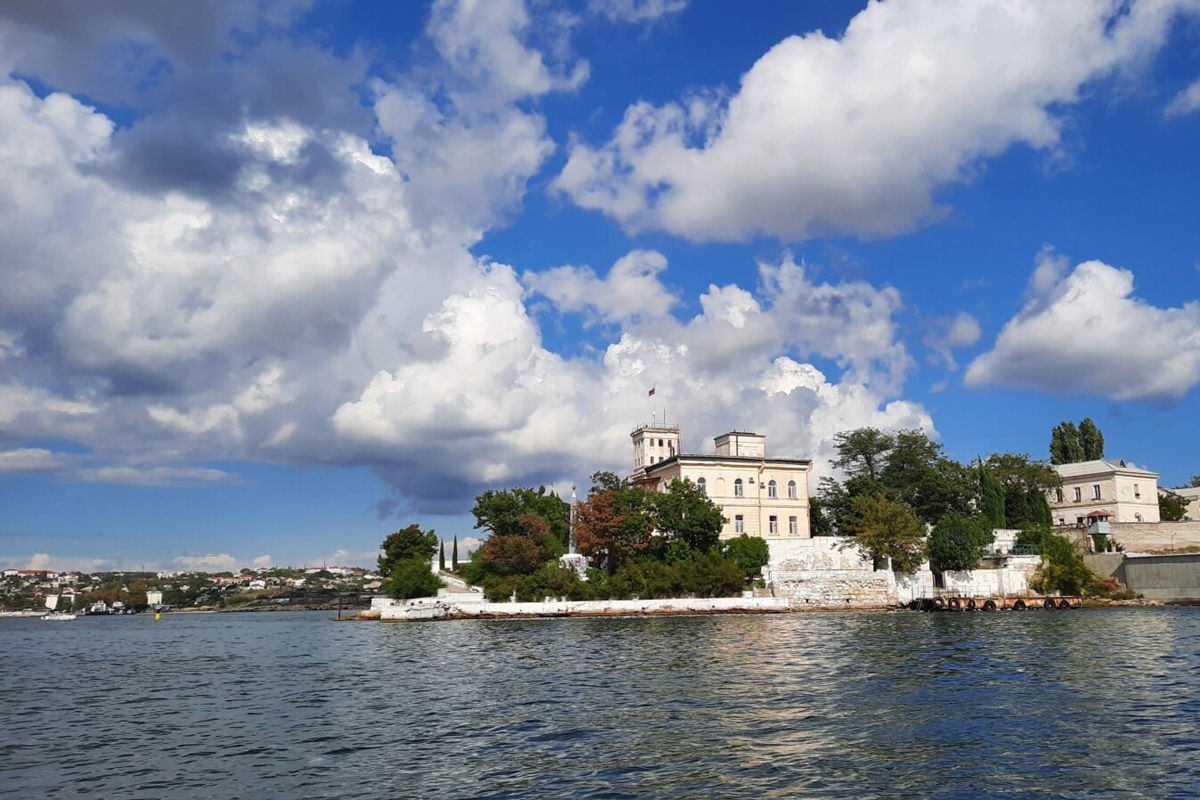 Before the Great War, the occupied peninsula had several Russian military hospitals, namely: the 640-bed 1472nd Naval Clinical Hospital in Sevastopol, its three branches in other cities totaling 410 beds, and a 200-bed war veteran hospital in Simferopol.
Before the Great War, the occupied peninsula had several Russian military hospitals, namely: the 640-bed 1472nd Naval Clinical Hospital in Sevastopol, its three branches in other cities totaling 410 beds, and a 200-bed war veteran hospital in Simferopol.
Prior to February 2022, the 1472nd hospital served not only Russian military personnel and their families, but also a certain general public quota. As of spring 2022, the admission of civilian patients virtually stopped.
In January 2023, it became known that a new military hospital would be built in Sevastopol. Later in the year, after a major renovation, the Sevastopol City Hospital #3 was handed over to the military. That was not an isolated case, however - since June 1, civilian hospital beds in Crimea have been allocated to the military on the regular basis, with the Ministry of Defense’s target totaling 5,000 beds.
In June 2023, the 220-bed inpatient City Hospital No. 9 in the Balaklava district of Sevastopol was closed to scheduled civilian patients. Meanwhile, the Sevastopol City Hospital #1, the oldest and largest in Sevastopol with an 893 inpatient capacity, currently accepts civilian patients only in emergency. Previously, the hospital performed 13,000 surgeries annually, almost half of the city’s total number of operations.
In June 2023, a 15 department 732-bed Simferopol’s Semashko Medical Center occupying a 65,000 square meter area, was transferred to the Russian military, with the city hospital # 7 awaiting the same. In addition, Russia has set up a field hospital on the outskirts of Simferopol where about a hundred Russian military personnel are undergoing rehabilitation.
In the meantime, Saki City Hospital is about to get a rehabilitation center for the Russian army servicemen on its territory, while Saki Physiotherapy Hospital will soon open a rehabilitation department for Russian military personnel. In Dzhankoy, however, the wounded are accommodated in a school building.
As Crimea’s resort towns of Yevpatoria and Saki have long specialized in the treatment and rehabilitation of severe musculoskeletal conditions, spine, limbs, etc., since 2014-15, their numerous health facilities have treated Russian military injured in the war in Chechnya and eastern Ukraine. The same contingent, but in considerably larger numbers, is using their services today.
The «human shield»
The above title seems more than fitting for a set up when a region of military hostilities that the Crimean peninsula is increasingly becoming, is deliberately and cynically used for children's recreation, including major international children's events, such as festivals and the like.
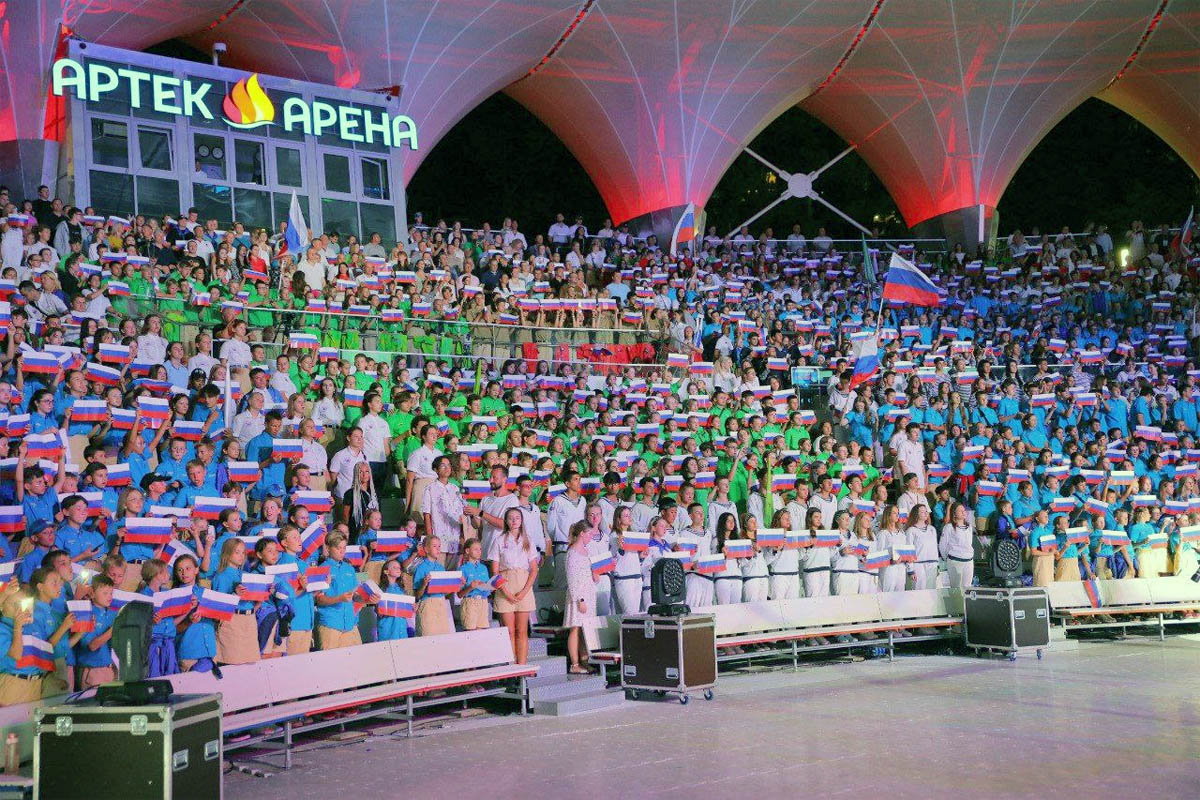 In July 2023, two international children's forums and festivals were organized in Crimea’s Artek center, bringing together children from Russia, other countries, and the Russian-occupied territories of Ukraine.
In July 2023, two international children's forums and festivals were organized in Crimea’s Artek center, bringing together children from Russia, other countries, and the Russian-occupied territories of Ukraine.
For instance, on July 30, 2023, Artek hosted the Festival of National Cultures «The Language of the World is the Language of Friendship» that according to the organizers, was attended by children from 44 countries who had passed the preliminary competitive selection.
«On the International Friendship Day, Artek hosted the Festival of National Cultures 'The Language of the World is the Language of Friendship.’» The Gorny Park’s Russian Glade was decorated with flags of 44 countries. In just a few hours, each Artek resident was able to visit Germany, Sweden, Spain, Israel, Lebanon, Syria, Egypt, Mongolia, Serbia, Kyrgyzstan, Kazakhstan and Armenia…» There were also reports of young participants from Palestine, Jordan, and South Ossetia.
Another event, the Artek Gathers Friends Forum, took place from July 31 to August 2, 2023. Participants were reported from Turkey, Ethiopia, Uzbekistan, South Ossetia, Armenia, Belarus, Uganda, Kazakhstan, China and many other countries.
«The Artek International Children's Forum gathers friends. It brings together children from all Russian regions and more than 50 countries. The forum program includes various activities to help children learn the characteristics of different countries’ cultures and traditions... The festive event was decorated with flags of all the countries the children came from... Each child wore his or hers national costume…»
Incredibly, on July 26, 2023, Russian President Vladimir Putin ordered for the new Artek branches to be opened by the end of the year in Sevastopol and... Berdyansk.
«The Government of the Russian Federation... shall ensure the opening in 2023 of branches of the federal state budgetary educational institution International Children's Center Artek, namely, children’s centers Korsun in Sevastopol and Krasnaya Gvozdika in Berdyansk, Zaporizhzhia region, providing for the allocation of additional federal budgetary funding for their 2023 operation in the amount of 260.1 million rubles,» reads the order.
The «dual-use» tourist facilities
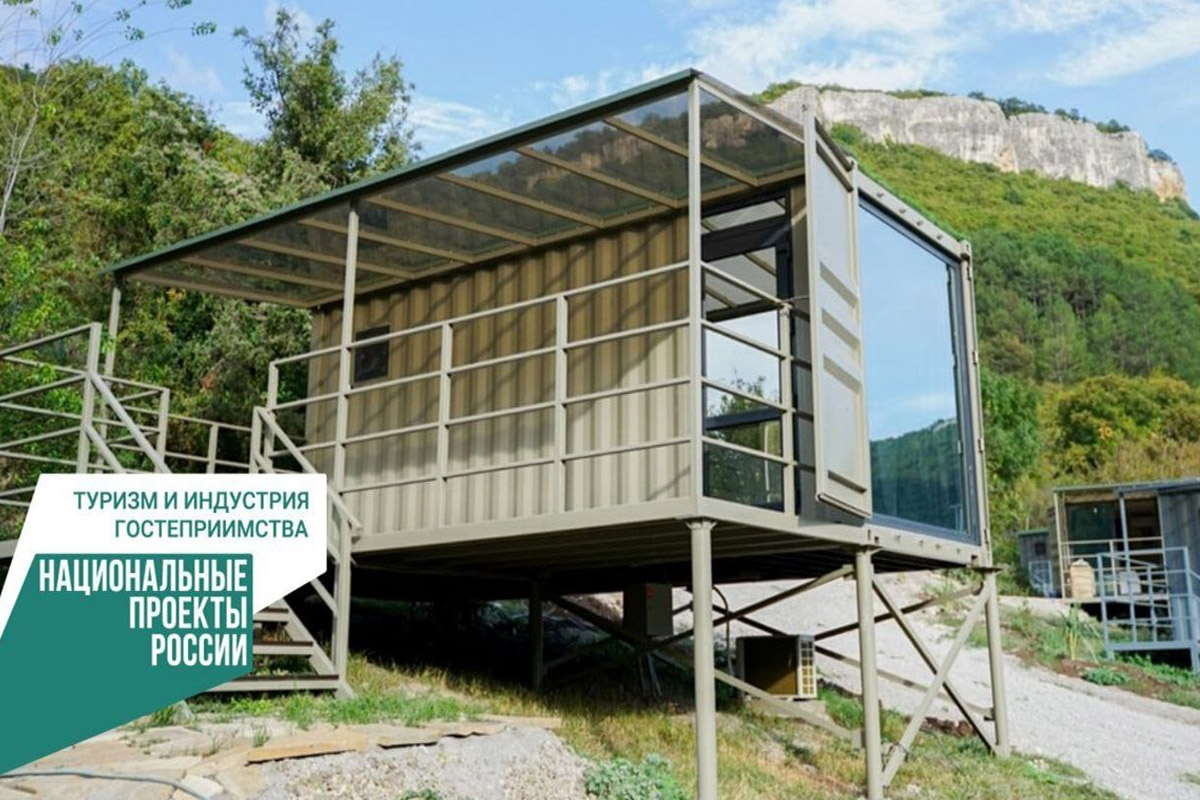 In 2022, Crimea became a construction site of quasi-tourist facilities and infrastructure that could be used for both civilian and military purposes.
In 2022, Crimea became a construction site of quasi-tourist facilities and infrastructure that could be used for both civilian and military purposes.
In April 2022, the Russian government initiated mass financing of the construction of prefabricated modular hotels in a number of Russian regions, including the occupied Crimea and Sevastopol. The Cabinet of Ministers allocated 4 billion rubles from the reserve fund for the creation of year-round modular hotels (Order No. 958-r of 21.04.2022).
Of the federal 4 billion rubles, 300 million were to be used to implement projects in Crimea and 150 million — in Sevastopol. Both began reporting on the construction before the start of the 2023 tourist season.
Recently, the Sevastopol Tourism Department reported that there were 5 projects in the works, specifically: 19 modules would be built in Orlyne, 10 — in the Cape Fiolent area, 48 — in Laspi Bay, 10 — around Balaklava and 14 — on Sevastopol’s north side.
In Crimea, 11 modular hotels appeared in the Simferopol, Leninsky and Bakhchisaray districts, as well as near Alushta, with a total capacity of 942 beds.
Even advanced Russian tourism experts are cautious about the modular initiative.
The natural questions that arise concern the reasons for the modular hotel construction initiative and the targeted contingent that will stay there — tourists, refugees or the Russian military. The rush to implement the «modular innovation» in Crimea and its inconsistency with the real market needs suggest the initiative has a camouflage lining.
Crimean tourist industry privileges and failed seasons paradoxes
The failed 2022 season hit the Crimean tourist industry hard, forcing it to apply for federal subsidies. This year, the business expects the situation to even worsen. Some hotels may simply stay shut, pushing their owners to the brink of bankruptcy.
Already in early 2022, the Crimean «authorities» appealed to the Russian government to support the Crimean and Sevastopol tourist industry and allocate money to pay the minimum wage in the winter months. Eventually, last October, 1.6 billion rubles were indeed allocated for that purpose.
At the end of March 2023, the Crimean occupation administration announced that Crimean businesses would receive financial support from the federal budget in the amount of 2 billion rubles, even if Russians did not vacation in Crimea in the summer. The assistance would be provided to companies that would keep their employees' jobs. Even in the complete absence of tourists, staff will receive the minimum wage from May to August.
In May 2023, the Russian Ministry of Economic Development drafted a resolution to further support the Crimea and Sevastopol tourist industry employment — 2.7 billion rubles from the government's reserve fund are to be distributed to 3.5 thousand organizations and individual entrepreneurs in Crimea. All of them will receive one-time payments of four minimum wages per employee. The number of recipients — about 40,000 — corresponds to the number of employees permanently employed in the industry year round.
It’s safe to assume that in order to receive the support, a private, state or municipal resort and tourism facility must fulfill certain conditions.
For example, the unheard-of generosity of the Crimean «authorities» who promise to compensate businesses for the loss of tourist traffic not only in winter but also, in summer, can be explained by just one thing: in the absence of regular tourists, Crimean carriers, hotels, restaurants and health centers actually serve «tourists in camouflage.» That is, in truth, they are being paid for the accommodation, food, treatment, and rehabilitation of the Russian military.
So, it seems that Russia would only benefit if there were fewer civilian tourists in 2023, since there are already more than enough people to fill the beds and dining halls as it is.
This year, it seems that Russia is content to have tourists in Crimea only on paper, since no one will know who the numbers actually list — civilians, military or refugees.
The paradoxical conclusion is that with the war approaching the peninsula, while the tourist season in Crimea is a flop, the loyalist tourist businesses won’t suffer. As long as they stay away from the attack-prone areas of the northern, eastern and western Crimea and get into the cohort of government-subsidized businesses, they will be compensated for the season’s failure. The latter is easy — one just needs to be coopted by the military interests of the Russian State.
To be continued...
* * *
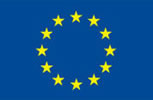 This article has been prepared with the generous support of the European Union in Ukraine. The content of the article is the sole responsibility of the authors and does not necessarily reflect the position of the European Union.
This article has been prepared with the generous support of the European Union in Ukraine. The content of the article is the sole responsibility of the authors and does not necessarily reflect the position of the European Union.
More on the topic
- 06.08.2023 Crimea During the Great War. Part 2. Extreme Tourism or «New Types of Tourism» and Tourist Numbers (2)
- 21.07.2023 Crimean Titan: Under a Russian Holding or a Ukrainian Tank?
- 12.06.2023 Crimea during the Great War. The situation in the occupied Crimea in 2022-2023. Military Context (1)
- 23.11.2021 Occupied Crimea. Exports and Imports / 2014-2021
- 23.11.2021 Water in Occupied Crimea / 2014-2021
- 23.11.2021 The Crimean Budget. Small Business. Salaries and Pensions / 2014-2021
- 23.11.2021 The "Trophy Economy". The Commercial Exploitation of Marine Biological Resources in the Black Sea and the Sea of Azov / 2014–2021
- 21.11.2021 The "Trophy Economy". Militarization as a Factor of Industrial Growth / 2014-2021
- 21.11.2021 Back in the USSR. The Reverse Restructuring of the Crimean Economy / 2014-2021
- 20.11.2021 The "Trophy Economy". The Development of the Stolen Ukrainian Black Sea Shelf / 2014-2021
- 20.11.2021 The Occupied Crimean Tourism / 2014-2021
- 20.11.2021 Investment. What the "Crimean" Federal Target Programme Finances / 2014-2021